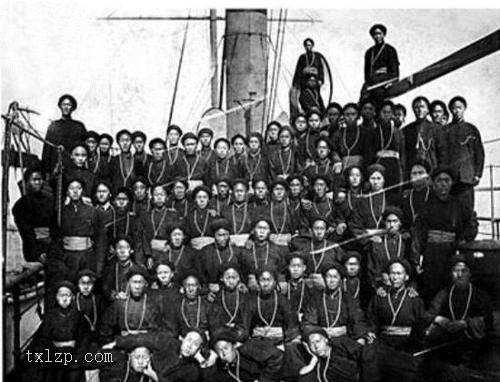Today, I would like to share with you a group of old photos of Dunhuang, Gansu Province in 1943, taken by Joseph Needham
In September 1943, Joseph Needham, the Scientific Counsellor of the British Embassy in China, set up an expedition to the northwest of China. During the expedition, he took a large number of old photos of the northwest region, as well as a large number of valuable images of the Mogao Grottoes in Dunhuang
Mogao Grottoes, commonly known as Thousand Buddha Cave, together with Luoyang Longmen Grottoes in Henan Province and Yungang Grottoes in Datong, Shanxi Province, are known as the three largest grottoes in China, which are located in Dunhuang at the western end of the Hexi Corridor. It was first built in the pre Qin period of the Sixteen Kingdoms. After the construction of the Northern Dynasty, the Sui Dynasty, the Tang Dynasty, the Five Dynasties, the Western Xia Dynasty, the Yuan Dynasty and other dynasties, it has formed a huge scale. There are 735 caves, 45000 square meters of murals and 2415 clay colored sculptures. It is the largest and richest Buddhist art place in the world
![图片[1]-The old photos of Dunhuang, Gansu in 1943. The scenery of Mogao Grottoes in Dunhuang 80 years ago-China Archive](https://chinaarchive.net/photo/republic-of-china/1-201220120235.jpg)
敦煌莫高窟下寺
![图片[2]-The old photos of Dunhuang, Gansu in 1943. The scenery of Mogao Grottoes in Dunhuang 80 years ago-China Archive](https://chinaarchive.net/photo/republic-of-china/1-201220120237-50.jpg)
莫高窟上、中寺
上、中寺院修建于清朝时期。照片拍摄当时上寺是国立敦煌艺术研究所(1940年代)办公、生活场所;中寺是常书鸿先生(敦煌文物保护创始人)的旧居。
![图片[3]-The old photos of Dunhuang, Gansu in 1943. The scenery of Mogao Grottoes in Dunhuang 80 years ago-China Archive](https://chinaarchive.net/photo/republic-of-china/1-201220120236-51.jpg)
这就是著名的敦煌月牙泉、鸣沙山
月牙泉(药泉、渥洼池、沙井),是敦煌八景之一(自汉朝开始);清朝时期名月牙泉(此地处在鸣沙山环抱之中,形似新月。)。鸣沙山位于敦煌西南沙漠,东西长四十公里,南北宽二十公里,鸣沙山因沙动成响得名。
![图片[4]-The old photos of Dunhuang, Gansu in 1943. The scenery of Mogao Grottoes in Dunhuang 80 years ago-China Archive](https://chinaarchive.net/photo/republic-of-china/1-201220120238.jpg)
中央通訊社摄影师羅寄梅夫人羅芳在莫高窟中寺外骑马 背景有喇嘛和警察 1943.10.1-5日
![图片[5]-The old photos of Dunhuang, Gansu in 1943. The scenery of Mogao Grottoes in Dunhuang 80 years ago-China Archive](https://chinaarchive.net/photo/republic-of-china/1-201220120239.jpg)
敦煌卖哈密瓜的小贩
![图片[6]-The old photos of Dunhuang, Gansu in 1943. The scenery of Mogao Grottoes in Dunhuang 80 years ago-China Archive](https://chinaarchive.net/photo/republic-of-china/1-201220120236.jpg)
大泉河东岸舍利塔
大泉位于南山谷中(距莫高窟十五公里)。此地的泉水流经莫高窟,唐朝名宕泉,后称大泉河。
![图片[7]-The old photos of Dunhuang, Gansu in 1943. The scenery of Mogao Grottoes in Dunhuang 80 years ago-China Archive](https://chinaarchive.net/photo/republic-of-china/1-201220120236-50.jpg)
莫高窟第415窟, 西壁佛龛内北侧天王像。
![图片[8]-The old photos of Dunhuang, Gansu in 1943. The scenery of Mogao Grottoes in Dunhuang 80 years ago-China Archive](https://chinaarchive.net/photo/republic-of-china/1-201220120237.jpg)
莫高窟第231-236 窟及上层第233窟
![图片[9]-The old photos of Dunhuang, Gansu in 1943. The scenery of Mogao Grottoes in Dunhuang 80 years ago-China Archive](https://chinaarchive.net/photo/republic-of-china/1-201220120238-50.jpg)
莫高窟北区洞窟
![图片[10]-The old photos of Dunhuang, Gansu in 1943. The scenery of Mogao Grottoes in Dunhuang 80 years ago-China Archive](https://chinaarchive.net/photo/republic-of-china/1-201220120240-50.jpg)
![图片[11]-The old photos of Dunhuang, Gansu in 1943. The scenery of Mogao Grottoes in Dunhuang 80 years ago-China Archive](https://chinaarchive.net/photo/republic-of-china/1-201220120240-51.jpg)
![图片[12]-The old photos of Dunhuang, Gansu in 1943. The scenery of Mogao Grottoes in Dunhuang 80 years ago-China Archive](https://chinaarchive.net/photo/republic-of-china/1-201220120241.jpg)
![图片[13]-The old photos of Dunhuang, Gansu in 1943. The scenery of Mogao Grottoes in Dunhuang 80 years ago-China Archive](https://chinaarchive.net/photo/republic-of-china/1-201220120241-50.jpg)
![图片[14]-The old photos of Dunhuang, Gansu in 1943. The scenery of Mogao Grottoes in Dunhuang 80 years ago-China Archive](https://chinaarchive.net/photo/republic-of-china/1-201220120242.jpg)
![图片[15]-The old photos of Dunhuang, Gansu in 1943. The scenery of Mogao Grottoes in Dunhuang 80 years ago-China Archive](https://chinaarchive.net/photo/republic-of-china/1-201220120242-50.jpg)
![图片[16]-The old photos of Dunhuang, Gansu in 1943. The scenery of Mogao Grottoes in Dunhuang 80 years ago-China Archive](https://chinaarchive.net/photo/republic-of-china/1-201220120243.jpg)
![图片[17]-The old photos of Dunhuang, Gansu in 1943. The scenery of Mogao Grottoes in Dunhuang 80 years ago-China Archive](https://chinaarchive.net/photo/republic-of-china/1-201220120239-50.jpg)

![[Qing Dynasty] British female painter—Elizabeth Keith, using woodblock prints to record China from the late Qing Dynasty to the early Republic of China—1915-China Archive](https://chinaarchive.net/wp-content/uploads/2022/11/image-191x300.png)



